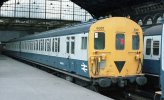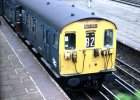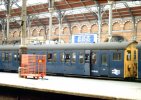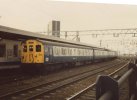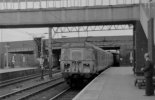Class AM1 was given to the ex-LNWR DC lines stock converted for ac OLE power. The Lancaster, Morecambe and Heysham branch was electrified with 6.6kV 25Hz ac. When BR were evaluating moving from their original 1500VDC electrification 'future standard', the self-contained line was chosen as a test bed for the burgeoning practice of powering direct from the national grid 50Hz supply, (mainly by SNCF). So the line was converted to 6.6kV 50Hz (utilising most of the existing OLE and its clearances) and the trains converted with new transformers and then quite new, mercury arc rectifiers. The electrification was successful but the line wasn't (in passenger terms) so it was closed in 1966. Given that the rolling stock originally started life in 1914, it was scrapped.
The LNWR had two types of EMUs for London district services; some with Siemens electrics, the rest with Oerlikon. The Siemens equipped stock was put into store at the beginning of (I think) WW2 when West London Line services were withdrawn as a war measure.
The original MR electric stock was withdrawn in 1951 and replaced by steam push-pull trains, usually worked by Jintys while the electrical system was modified; most of the MR OHE was retained - mainly wooden telegraph poles with metal cross beams! - but there was a section west of the bridge carrying the WCML over the line which had new catenary, including some sections with concrete masts. A new station at Scale Hall was constructed near the WCML bridge in the late 1950s, and had a very short life.
To work it, the Siemens equipped stock was taken out of store, refurbished (I think at Wolverton), and equipped to work from an AC overhead system; these were subsequently classed AM1. Although used in normal passenger service, they were test-beds; one had the first Faiveley "half-pan" to be fitted in the UK, and another was the first in the world to be fitted with a Germanium rectifier.
The trains had open saloons, and comfortable seats; I did say that - COMFORTABLE seats! Internally, they didn't look like 40 year old trains, and were very popular locally.
I lived in Lancaster at that time, and actually saw one sparking along on it's first day out in Lancashire, but I'm sure I've seen a photo of one undergoing some testing in the London area on the line from Bow Junction towards Fenchurch Street which was electrified at 1500v DC. No idea how that worked!
I think you are correct. Only the locomotives were referenced in DC = EM1 and EM2 (think there was a planned EB for banking too) - I think those codes may have come from the LNER too. The AL and AM thing was under BR, and although BR left the "EM" in place they never designated the Hadfield sets until they were 506. Just 8 units at Reddish Depot, I guess they knew what they were without a reference !
There was a range of identification letters for the ex LNER electric locos:
EM1 and EM2 were the MIXED TRAFFIC locos built for the Manchester, Sheffield, Wath scheme of the early 1950s
EF1 were the electric FREIGHT locos built by the NER for the Shildon - Newport scheme
EB1 was the one EF1 converted for use as a BANKER on the MSW scheme; it subsequently became a depot pilot at Ilforq
EE1 was Raven's prototype EXPRESS loco for the NER's planned electrification of the York - Newcastle main line
ES1 were the electric SHUNTING locos built for the Tyne Commission Quay branch in Newcastle, and for shunting at Gosforth Depot; one of these is in the National Collection
Only the EM1s and EM2s were given TOPS numbers (76 and 77 respectively)

